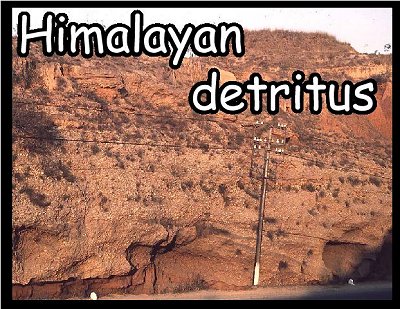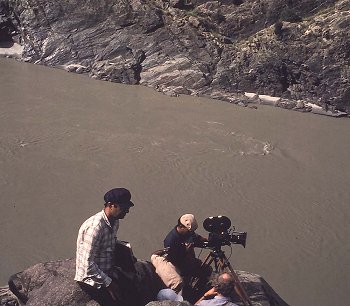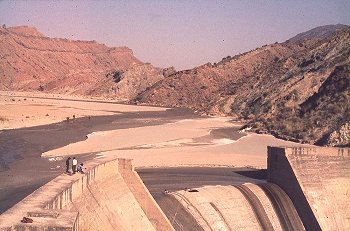

 High
mountains are major sites of weathering and erosion. Steep hillsides shed detritus
easily which, around the high mountains, are carried by glaciers.
High
mountains are major sites of weathering and erosion. Steep hillsides shed detritus
easily which, around the high mountains, are carried by glaciers.
 The
next stage is for the detritus to be carried down the rivers, swollen in the
summer by glacial melt-water and fed by monsoonal rainfall. The sediment loads
make river water murky. The strongly flowing rivers carry suspended sand and
silt, eventually dumping this is areas where the stream gradient and water flow
speed decline.
The
next stage is for the detritus to be carried down the rivers, swollen in the
summer by glacial melt-water and fed by monsoonal rainfall. The sediment loads
make river water murky. The strongly flowing rivers carry suspended sand and
silt, eventually dumping this is areas where the stream gradient and water flow
speed decline.
 The
sedimentation rates can be very high - metres a year - which causes great problems
for hydro-reservoirs in the region. Sediment can be stored in the high mountains
but most is carried out - dumped in thick sedimentary basins adjacent to the
mountains. These foreland basins are formed by the mountain building but this
can continue, bull-dozering the detritus quickly after it was deposited. The
courses of rivers can be altered as folds grow on the edge of the foreland basin.
Older deposits are uplifted and eroded out, recycling detritus back into the
rivers.
The
sedimentation rates can be very high - metres a year - which causes great problems
for hydro-reservoirs in the region. Sediment can be stored in the high mountains
but most is carried out - dumped in thick sedimentary basins adjacent to the
mountains. These foreland basins are formed by the mountain building but this
can continue, bull-dozering the detritus quickly after it was deposited. The
courses of rivers can be altered as folds grow on the edge of the foreland basin.
Older deposits are uplifted and eroded out, recycling detritus back into the
rivers.
But the eventual sinks for the sediment are the nearby oceans - into the Bengal and Indus fans. The Bengal Fan is one of the thickest accumulations of sediment in the world, over 20 km thick. Indeed much of the country of Bangladesh is built on the top of the fan - which even here lies on top of oceanic crust.
So the Himalayas shed lots of sediment. Tibet doesn't - largely because it is internally drained and not eroding anything like as efficiently. The exceptions are its flanks, which are eroding very quickly, on the East cut by some of the world's great rivers that are fed by the monsoon rains.